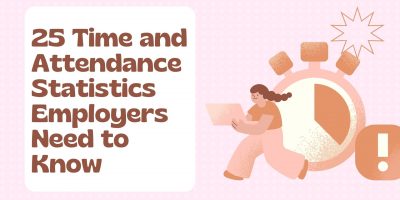
50+ Identity Theft Statistics Employers Should Know
Stay informed with key identity theft statistics that every employer should be aware of, safeguarding sensitive information and protecting your workforce.

The workplace environment has dramatically changed with the digital advancements of the modern era. Today, the workplace revolves around endless meetings, deadlines, heavy workloads, email management, and many more activities.
All such scenarios are triggering stress in the workplace.
As per the survey from the American Institute of Stress, 82% of employees have reported that they feel at least some stress at the workplace, while 6% reported extreme stress. In fact, there’s an enormous amount of data in the form of workplace stress statistics that show how challenging it is for employees to deal with work-induced stress.
However, the primary goal of smart organizations is to provide opportunities to boost employees’ performance. Consequently, provide opportunities for organizational growth, innovation, and improvement.
To do so, it’s important to understand the nature of human performance.
The simple explanation provided by organizational psychologists is that employees’ performance is a result of employees’:
These factors need to be fulfilled to expect high employee productivity, well-being, and satisfaction. And of course, to reduce work-induced stress.
The following ten workplace design adjustments can help in achieving this goal:
The right combination of temperature, humidity, and airflow provides thermal comfort in the workplace.
Workplace Solutions:
There are many benefits of people spending time outside, in the nature. Therefore, it is important to design an environmentally conscious workplace and bring nature into the office.
Workplace Solutions:
Both sensory change and variability are important factors to be considered in the workplace. The lack of various stimulations during the workday can affect employees’ concentration and stay alert.
Even though different people prefer different colors, there are guides on choosing colors to produce the desired effect. For instance:
Noise can be a great disruptor in the office. However, noise can be a booster for productivity, depending on the type of work. Still, being able to control and adjust noise individually is a key.
Crowding decreases employee satisfaction. Environmental psychologists like Sally Augustin highlights how people perceive space:
Ergonomics stands for the people’s efficiency in their work environment. It can include ways to be more comfortable, flexible, and productive. The study of ergonomics also cares for safety in the workplace, product design, reduction of human errors, human capabilities, and more.
By improving indoor air quality, employers improve and support employees’ health.
The best offices are those that let their employees thrive. This means, offer opportunities for learning, growth, collaboration, and more.
A healthy employee means more productivity and business growth. A workplace should not be so business-oriented that it fails to consider the employees’ well-being as one of its top priorities. An employee wellness program plays a crucial role in the employees’ well-being and health. An employee wellness program can include:
An effective employee wellness program increases the productivity and morale of employees and reduces absenteeism and healthcare cost.
It is well-acknowledged that mindfulness-based therapy is highly effective in reducing stress, depression, and anxiety. Most of the employees are so absorbed in their daily work and personal lives that they don’t get time to carry out mindfulness activities. Therefore, if employers can encourage mindfulness meditation in the workplace, it can significantly reduce stress.
The HR department can introduce different mindfulness-based therapies and classes, such as yoga lessons, breathing exercises, and other similar activities, to make employees feel relaxed.
Most employers don’t know how much workload their employees are bearing. Sometimes, a single employee has to handle the workloads of 2-3 employees. Therefore, there is a need to have a check and balance system while assigning workloads. Some of the strategies you can adopt are:
Make employees part of the decision-making process when assigning tasks to them, and then mutually decide the deadlines and other details.
Practice rotational workload shifts such that employees get a mix of low-stress and high-stress work gradually.
Become more supportive in setting timeframes for projects and provide more supplies and resources employees need to deliver high-quality performance.
The traditional working hours are usually 9 am to 5 pm, but the modern advanced era does not just stick to it. Nowadays, employees are assigned tasks and given specific deadlines to complete them. So, making them stick with the traditional working hours isn’t very fruitful.
There is a type of employee time tracking software that lets them work whenever they want. Employees just have to track their hours when they start and finish working so that they log the number of hours required of them by the end of the week or month.
Besides that, your employees are a mix of young professionals, women, parents, etc. If you develop a flexible working environment where the office is open all the time, and there are no specific work hours tracking, employees will find it less stressful and work in the hours they feel more productive.
Besides that, a flexible work environment also helps to attract top talent who likes the idea of work flexibility.
The traditional working hours are usually 9 am to 5 pm, but the modern advanced era does not just stick to it. Nowadays, employees are assigned tasks and given specific deadlines to complete them. So, making them stick with the traditional working hours isn’t very fruitful.
There is a type of employee time tracking software that lets them work whenever they want. Employees just have to track their hours when they start and finish working so that they log the number of hours required of them by the end of the week or month.
Besides that, your employees are a mix of young professionals, women, parents, etc. If you develop a flexible working environment where the office is open all the time, and there are no specific work hours tracking, employees will find it less stressful and work in the hours they feel more productive.
Besides that, a flexible work environment also helps to attract top talent who likes the idea of work flexibility.
It is common to see employees feeling stressed at the workplace, but the way they handle the stress is the primary concern. It is difficult for employees to manage stress on their own if they’re only focused on the workload, so employers must set up such strategies at the workplace.
Companies have various methods at their disposal that can negate the consequences of work-induced stress. For example, they can try the stress recovery effect behavior-based program created by Drs. Nick Hall and Dick Tibbits.
Browse our curated list of vendors to find the best solution for your needs.
Subscribe to our newsletter for the latest trends, expert tips, and workplace insights!

Stay informed with key identity theft statistics that every employer should be aware of, safeguarding sensitive information and protecting your workforce.

Beyond holiday festivities and annual performances, here’s why December’s focus should be about celebrating human rights in the workplace.

How does workplace design affect productivity? Can the corporate workplace be a place that offers both meaning and efficiency?

Gain vital time and attendance insights to manage workforce punctuality and productivity effectively.
Used by most of the top employee benefits consultants in the US, Shortlister is where you can find, research and select HR and benefits vendors for your clients.
Shortlister helps you reach your ideal prospects. Claim your free account to control your message and receive employer, consultant and health plan leads.